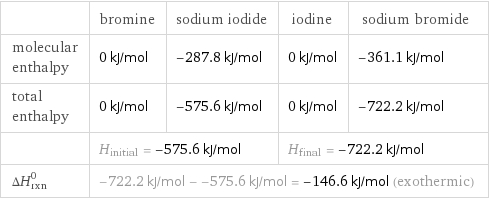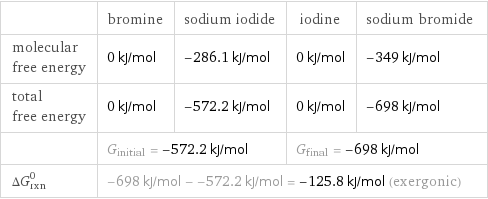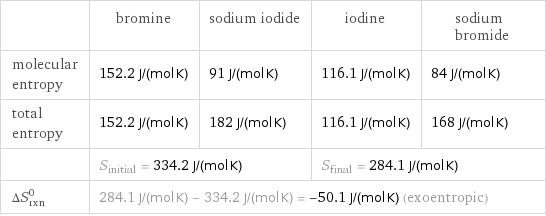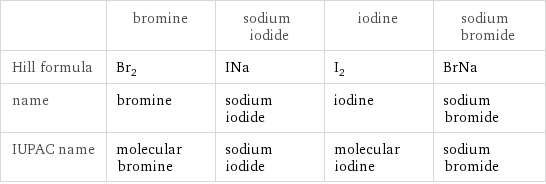Input interpretation

bromine + sodium iodide ⟶ iodine + sodium bromide
Balanced equation

Balance the chemical equation algebraically: + ⟶ + Add stoichiometric coefficients, c_i, to the reactants and products: c_1 + c_2 ⟶ c_3 + c_4 Set the number of atoms in the reactants equal to the number of atoms in the products for Br, I and Na: Br: | 2 c_1 = c_4 I: | c_2 = 2 c_3 Na: | c_2 = c_4 Since the coefficients are relative quantities and underdetermined, choose a coefficient to set arbitrarily. To keep the coefficients small, the arbitrary value is ordinarily one. For instance, set c_1 = 1 and solve the system of equations for the remaining coefficients: c_1 = 1 c_2 = 2 c_3 = 1 c_4 = 2 Substitute the coefficients into the chemical reaction to obtain the balanced equation: Answer: | | + 2 ⟶ + 2
Structures

+ ⟶ +
Names

bromine + sodium iodide ⟶ iodine + sodium bromide
Reaction thermodynamics
Enthalpy

| bromine | sodium iodide | iodine | sodium bromide molecular enthalpy | 0 kJ/mol | -287.8 kJ/mol | 0 kJ/mol | -361.1 kJ/mol total enthalpy | 0 kJ/mol | -575.6 kJ/mol | 0 kJ/mol | -722.2 kJ/mol | H_initial = -575.6 kJ/mol | | H_final = -722.2 kJ/mol | ΔH_rxn^0 | -722.2 kJ/mol - -575.6 kJ/mol = -146.6 kJ/mol (exothermic) | | |
Gibbs free energy

| bromine | sodium iodide | iodine | sodium bromide molecular free energy | 0 kJ/mol | -286.1 kJ/mol | 0 kJ/mol | -349 kJ/mol total free energy | 0 kJ/mol | -572.2 kJ/mol | 0 kJ/mol | -698 kJ/mol | G_initial = -572.2 kJ/mol | | G_final = -698 kJ/mol | ΔG_rxn^0 | -698 kJ/mol - -572.2 kJ/mol = -125.8 kJ/mol (exergonic) | | |
Entropy

| bromine | sodium iodide | iodine | sodium bromide molecular entropy | 152.2 J/(mol K) | 91 J/(mol K) | 116.1 J/(mol K) | 84 J/(mol K) total entropy | 152.2 J/(mol K) | 182 J/(mol K) | 116.1 J/(mol K) | 168 J/(mol K) | S_initial = 334.2 J/(mol K) | | S_final = 284.1 J/(mol K) | ΔS_rxn^0 | 284.1 J/(mol K) - 334.2 J/(mol K) = -50.1 J/(mol K) (exoentropic) | | |
Equilibrium constant
![K_c = ([I2] [NaBr]^2)/([Br2] [NaI]^2)](../image_source/e87affd9cb60a690a0ec06dd9805c9c4.png)
K_c = ([I2] [NaBr]^2)/([Br2] [NaI]^2)
Rate of reaction
![rate = -(Δ[Br2])/(Δt) = -1/2 (Δ[NaI])/(Δt) = (Δ[I2])/(Δt) = 1/2 (Δ[NaBr])/(Δt) (assuming constant volume and no accumulation of intermediates or side products)](../image_source/ecde94d430d50cd4d7d067e3de85dd71.png)
rate = -(Δ[Br2])/(Δt) = -1/2 (Δ[NaI])/(Δt) = (Δ[I2])/(Δt) = 1/2 (Δ[NaBr])/(Δt) (assuming constant volume and no accumulation of intermediates or side products)
Chemical names and formulas

| bromine | sodium iodide | iodine | sodium bromide Hill formula | Br_2 | INa | I_2 | BrNa name | bromine | sodium iodide | iodine | sodium bromide IUPAC name | molecular bromine | sodium iodide | molecular iodine | sodium bromide
Substance properties

| bromine | sodium iodide | iodine | sodium bromide molar mass | 159.81 g/mol | 149.89424 g/mol | 253.80894 g/mol | 102.89 g/mol phase | liquid (at STP) | solid (at STP) | solid (at STP) | solid (at STP) melting point | -7.2 °C | 661 °C | 113 °C | 755 °C boiling point | 58.8 °C | 1300 °C | 184 °C | 1396 °C density | 3.119 g/cm^3 | 3.67 g/cm^3 | 4.94 g/cm^3 | 3.2 g/cm^3 solubility in water | insoluble | | | soluble surface tension | 0.0409 N/m | | | dynamic viscosity | 9.44×10^-4 Pa s (at 25 °C) | 0.0010446 Pa s (at 691 °C) | 0.00227 Pa s (at 116 °C) |
Units
